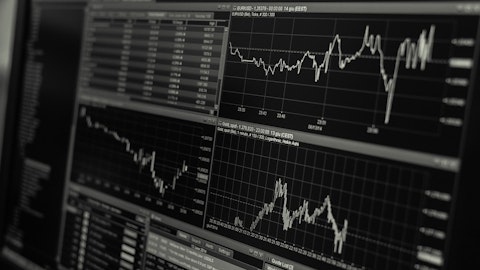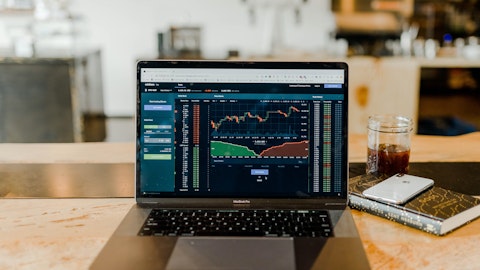Todd Schneider: Good morning, Manav. Great question. As Mike said, we win in many ways. We have been selling no programmers since the inception of my career, I can tell you that, and we continue to. And I’ll just remind you, there is — we service a little over a million businesses, but there’s 16 million businesses in the US and Canada, so there’s plenty of opportunity there. And we like both. We certainly win some from the competitors. We like growing the pie. And then the examples I was giving, it’s a mix. But in large part, it is — they were either doing it in house, meaning they were processing microfibers in house, or they were telling their employees to go buy product. So there’s different variations of no programmers, meaning some are just — were buying products and providing to their people and telling them to wear them.
Some of them, they were just telling them to show up to work and look good. But nevertheless, we bring so much better consistent program identification, cleanliness, all these and compliance are big drivers for our customers.
Manav Patnaik: Got it. And then just on the capital allocation front, I mean, the buyback number one of the bigger quarters for a while now. I mean, is that any indication of the M&A market slowing down or just how we should think about that balance there?
Mike Hansen: Manav, we — no change in what we’re seeing in M&A. Still we’re working the pipeline as best we can. We’ve made some nice acquisitions this year. From a buyback perspective, you’ve heard us speak to it being an opportunistic execution. And that’s what you saw this quarter. As we think back about our first quarter results, and we thought they were pretty good, the stock reacted a little bit negatively, and we saw that as a nice opportunity and we took advantage of it. So that is a — it was a good example during the quarter of an opportunistic execution of that buyback program. And the beauty, Manav, as we speak about our capital allocation, we don’t always have to choose right in the quarter or maybe let’s call it for the year.
We’ve invested in the business as we’ve talked about. Our CapEx is up, which is important to us as a part of that investment. M&A is up from last year. Dividends are up 17% from last year, and we’ve been able to execute on the buyback program. So when you hear us talk about the sort of the four levers of capital allocation, we’ve done them all, I think, nicely this year. And again, the beauty of our cash flow and our balance sheet is we don’t really have to choose.
Todd Schneider: Mike, I would just add that we think we’re being really good fiduciaries of our shareholders’ investments. Mike mentioned all the levers. And the net-net of that is we still have great dry powder, which allows us to take on M&A of all shapes and sizes and we’re interested in that.
Operator: And our next question comes from Joshua Chan from UBS. Please go ahead, Joshua.
Joshua Chan: Hi. Good morning. Thanks for taking my questions. So, Todd, you mentioned the opening of the cleanrooms. I was just wondering if you can kind of frame for us what you see as the attractive parts of this business. How is it attractive? And what kind of opportunity does it mean for Cintas going forward in the cleanrooms?
Todd Schneider: Thanks for the question, Josh. Yeah, the cleanroom business is, it’s an attractive sector for us. I mentioned pharmaceutical and biotechnology companies, and there’s — it seems like there’s more and more every year that need that level of cleaning, that level of cleanliness. So, that is — we think that bodes well for that business in the future. And there has been — you’ve seen some momentum onshoring in that area. And we want to make sure that we have the appropriate capacity to serve our current customers and that we’re prepared for the future as well. So, we like the trends in that business, and we like the business.
Joshua Chan: Great. Thank you for the color there, Todd. And, in fact, if I can follow up with the margin question, I guess, if in the future, the energy favorability were to lessen, could you talk to the opportunities that you still have to drive margin expansion and the targeted incremental margins going forward without as much energy tailwind?
Todd Schneider: Yeah. Great question. Yeah. So, we recognize that energy prices go up, they go down. But one thing that’s going to be consistent is, we’re going to be focused on extracting out inefficiencies in our route structure and in our production facilities. So, that will be really important to us. And we think there is certainly ample opportunity there still to go. We’ve talked about the SmartTruck technology, that’s been impactful to us in many ways. But what’s also impactful is, as Mike mentioned, our Six Sigma team of professionals, our Engineering professionals, and then layering in with that technology allows us to have a centralized visibility into our operations at a level that we’ve never had before in the history of the company this technology allows us.
So — and it allows us to maximize our labor, our equipment, ultimately our energy spend. So — and we’re focused on extracting out those inefficiencies, so that we can manage it moving forward. We love when energy goes — costs go down, but we recognize those markets will move, but we’re going to be focused on extracting out those inefficiencies.
Operator: And our next question comes from Heather Balsky from Bank of America. Please go ahead, Heather.
Heather Balsky: Hi. Sorry about that. Thank you for taking my question. And first question with regards to the programmers and non-programmers, as we’re further and further out from the COVID period, are you still seeing the shift in demand in terms of more non-programmers looking to outsource, or do you think it’s starting to normalize back to pre-COVID trends?





